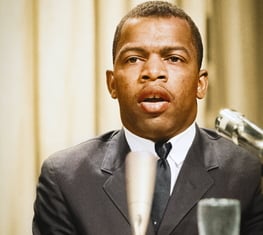This article originally appeared in Blue Ridge Now.
By Molly McGowan
A younger, well-informed wave of early voters will join those casting their ballots for the general election Nov. 4, as local students participate in a Kids Voting Henderson County mock election facilitated by local teachers.
A younger, well-informed wave of early voters will join those casting their ballots for the general election Nov. 4, as elementary, middle and high school students participate in a Kids Voting for Democracy mock election facilitated by local teachers.
In collaboration with the League of Women Voters of Henderson County, teachers with Henderson County Public Schools are working to ensure the next generation of voters is an informed one.
Addie Carr, an eighth-grade social studies teacher at Apple Valley Middle, and Carson LeMaster, school library media coordinator at Clear Creek Elementary, began facilitating the Kids Voting for Democracy program in HCPS, with the guidance of LWV member Marian Lowry - who has led the Henderson County chapter of Kids Voting USA for more than 10 years.
The program’s goal is to teach children about the voting process and their democratic right to vote, create informed future voters, and involve parents in students’ civic education, they told Henderson County Board of Education on Monday.
Following the nation’s trend of moving from paper to digital ballots, Kids Voting for Democracy switched to online voting during the May primary election, said Assistant Superintendent for Curriculum & Instruction Kathy Revis.
She said more than 1,500 Henderson County students voted during the primary, with elementary students using desktops in their media centers, middle school students using school iPads, and high school students voting on iPads and personal iPhones.
“We do a mock registration (and) secret ballot, so kids know that voting is their choice and what they vote for is their choice,” LeMaster said. “We discuss the difference between fact and opinion.”
With information geared toward different grade levels, Kids Voting for Democracy explains the vocabulary associated with the voting process and different positions in government for which candidates are running, and offers websites where children can learn more about candidates.
“They do a lot of the research through those websites,” LeMaster said.
Older students receive the same candidate information their parents and other adults receive in local newspapers and from the League.
“In the high schools, we actually provide the voter guides,” Carr said.
LeMaster said the voting window is several weeks, held during the early voting period, so the process is flexible for teachers.
And since teachers have lesson plans of their own to create, LeMaster and Carr provide the materials for the classroom.
“I actually created a video on my computer for my teachers to show to their students,” LeMaster said. “I’ve had a lot of positive feedback from teachers,” she added, as kids get excited about the activities.
Feedback from parents has been that a primary election is too difficult for the youngest children to understand. So Kids Voting Henderson County will continue to focus only on general elections – and won’t make students study every race.
Kids in kindergarten and first grade learn about one local and one state race, and this year they’re voting for Henderson County sheriff and the N.C. Supreme Court chief justice.
Grades two through five learn about those races, as well as the local school board race and candidates running for N.C. State Senate, District 48. Middle and high school students vote for candidates in the same four races, as well as those in federal House and Senate races.
Sample ballots are sent home with students to remind adults that it’s time to vote, and student leaders within the upper grades are expected to know the current political issues, how adults can access polls and when voting starts – in case parents have any questions.
Carr said about 90 percent of schools within the system are participating this year, and she and LeMaster are hoping to grow that number.
“The goal is to get every single school (participating),” Carr said. “It’s all about becoming 21st-century learners.”





